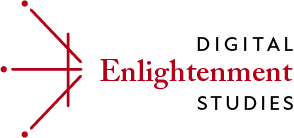The appearance of a journal dedicated to ‘Digital Enlightenment Studies’ will come as no surprise to anyone in the field. The 18th century has long been the focus of creative work in the digital humanities – and to a much greater degree than other centuries. But why is this the case? It cannot only be a copyright story, as works from every period before the 1920s are in the public domain. And digitisation efforts have been fairly universal in scope. 18th-century editions even present digitisation obstacles missing from, say, nineteenth-century ones, most notably the medial ‘ſ’ (which to date most OCR programs still render as an ‘f’).
So why is it that digital Enlightenment studies seems like an obvious subject for a scholarly journal, while ‘digital Renaissance’ or ‘digital Realism’ might not? The simple answer, I believe, is that Enlightenment studies have benefited from an incredible head start. Probably the three most important projects in this area (two of which are represented by the editors of this journal) are the digital Encyclopédie, created by the ARTFL Project at the University of Chicago; the Electronic Enlightenment project (EE), which grew out of the Voltaire Foundation at the University of Oxford; and Eighteenth-Century Collections Online (ECCO), assembled by Gale Cengage. What made these projects so remarkable was not just that they digitised large corpora – plenty of other projects did that as well. These projects did something much more transformative: they made it possible to research corpora that were so large that they eluded traditional methods. Obviously, scholars had studied the Encyclopédie, Enlightenment correspondences, and other 18th-century texts before. But they could only realistically study them in a piecemeal fashion: a set of Encyclopédie articles here, a subset of letters or texts there. Suddenly, and amazingly, scholars could pose questions relating to an entire corpus. The very nature of studying the field changed with the advent of these incredible resources.
But that wasn’t all that made these resources so novel. They also pioneered new research techniques. The ARTFL Project stands out for its development of search functions that vastly augment the possibilities of digital research. In addition to proximity searches, collocation indexes and multi-faceted searches (e.g. search only in Encyclopédie articles authored by Diderot in volume 1), the ARTFL team also devised a method of ‘textual alignment’ for matching similar passages. This technique allows scholars to track quotations, plagiarism and other kinds of textual recycling across multiple works. Rather than having to search for a particular string of text in the Encyclopédie, users can look for all quotations of, say, Montesquieu’s De l’esprit des lois across the seventeen volumes of text.
The EE project similarly made it possible to read correspondences through different prisms. Users can now easily flip through the correspondence exchanged between two individuals (say, Voltaire and Catherine II), rather than having to jump around multiple printed volumes. Or they can select a location (e.g. ‘University of Oxford’) and see which letters were sent to or from that place. The faceted search functionality also brings a whole new dimension to simple word searches. To which correspondents does Voltaire write about ‘philosophie’, ‘lumières’ or ‘révolution’? After what year do these and other terms enter into his vocabulary?
EE also brought new forms of data into play. First, there was the metadata of the letters themselves, which my Stanford colleagues and I geo-located for our Mapping the Republic of Letters project. What was the geography of the Enlightenment? What were the hotspots and the coldspots? To what extent was this a cosmopolitan, national or francocentric enterprise?
There is also much to be learned about the individuals who participated in the Enlightenment. Here as well, EE paved the way by collecting data about correspondents. Standardising and analysing these data can teach us a great deal about the social composition of the Enlightenment. Was it predominantly an elite affair? To what extent did it encompass the sciences? What were the most represented professions? And do the answers to these questions vary by nationality?
Scholars have really only scratched the surface of these questions. We have tremendous amounts of digitised text and data, but in some respects the hardest part is still to come. Our digital corpora are siloed, making cross-corpus studies challenging. We have no unified database of 18th-century authors and contributors – a ‘White Pages of the Enlightenment’, so to speak. Libraries such as the Bibliothèque nationale de France are making it much easier to access their own metadata holdings (through such websites as data.bnf.fr), but managing, sorting and searching through these data remains daunting.
In the spirit of Enlightenment utopianism, then, one can dream of a future (to arrive before Mercier’s year 2440?) when researchers can seamlessly glide between prosopographical data about an author, information about their correspondents, a list of their works published in a specific town (which might not be the same as the place stated on the title page), and a portal that allows these texts to be mined or compared with others written that year. Of course, these kinds of grand institutional projects come with their own set of risks. Are the financial investments worth the scholarly outcomes? If we build it, will the researchers come? Perhaps modern fantasies of rational information systems are a mirage. In the meantime, perhaps we would do best to follow more sober, Enlightenment guidance, and cultivate the fruits of our existing digital gardens.
